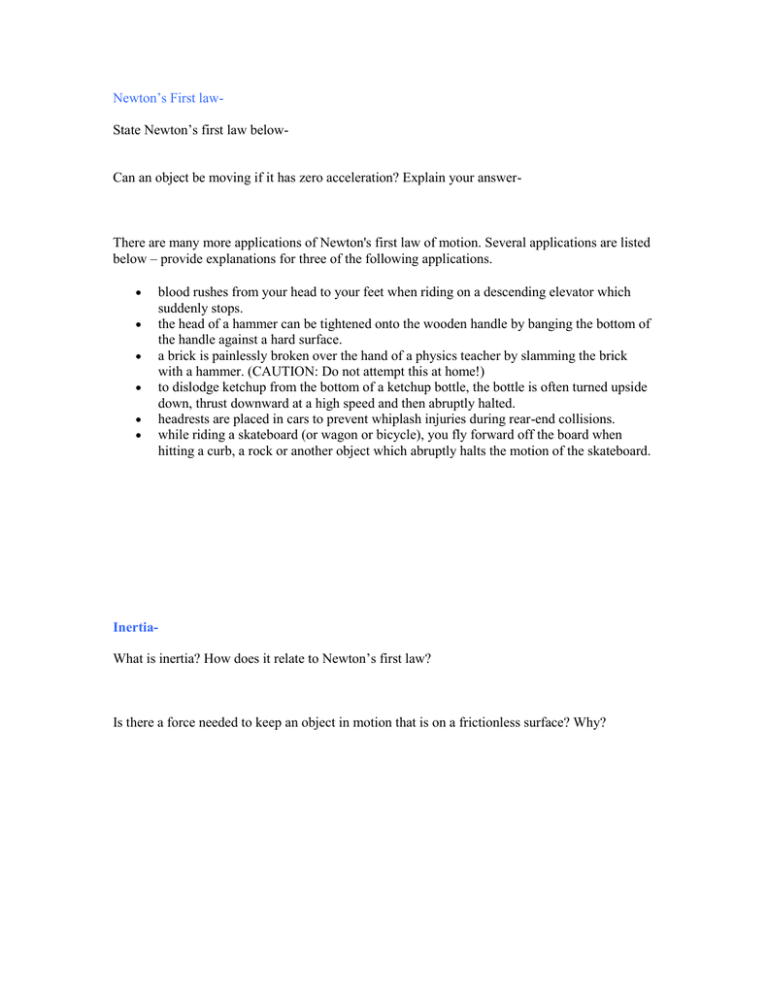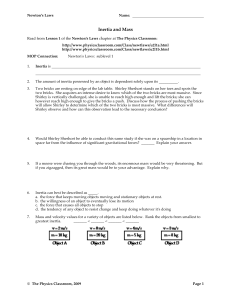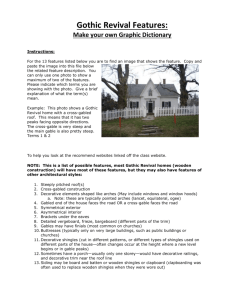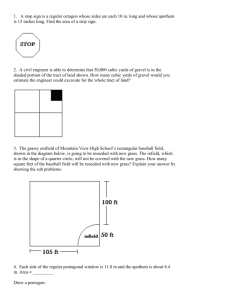Newton’s First law- State Newton’s first law below-
advertisement

Newton’s First lawState Newton’s first law below- Can an object be moving if it has zero acceleration? Explain your answer- There are many more applications of Newton's first law of motion. Several applications are listed below – provide explanations for three of the following applications. blood rushes from your head to your feet when riding on a descending elevator which suddenly stops. the head of a hammer can be tightened onto the wooden handle by banging the bottom of the handle against a hard surface. a brick is painlessly broken over the hand of a physics teacher by slamming the brick with a hammer. (CAUTION: Do not attempt this at home!) to dislodge ketchup from the bottom of a ketchup bottle, the bottle is often turned upside down, thrust downward at a high speed and then abruptly halted. headrests are placed in cars to prevent whiplash injuries during rear-end collisions. while riding a skateboard (or wagon or bicycle), you fly forward off the board when hitting a curb, a rock or another object which abruptly halts the motion of the skateboard. InertiaWhat is inertia? How does it relate to Newton’s first law? Is there a force needed to keep an object in motion that is on a frictionless surface? Why? Think and explain the followingMr. Wesley spends most Sunday afternoons at rest on the sofa, watching pro football games and consuming large quantities of food. What effect (if any) does this practice have upon his inertia? Explain. Ben is being chased through the woods by a Moose which he was attempting to photograph. The enormous mass of the Moose is extremely intimidating. Yet, if Ben makes a zigzag pattern through the woods, he will be able to use the large mass of the moose to his own advantage. Explain this in terms of inertia and Newton's first law of motion. Two bricks are resting on the edge of a lab table. Shirley stands on her toes and spots the two bricks. She acquires an intense desire to know which of the two bricks is more massive. Since Shirley is vertically challenged, she is unable to reach high enough and lift the bricks; she can, however, reach high enough to give each brick a push. Discuss how the process of pushing the bricks will allow Shirley to determine which of the two bricks is more massive. What difference will Shirley observe and how can this observation lead to the necessary conclusion? State of motion- 1. Several physics teachers are taking some time off to play a little putt-putt golf. The 15th hole at the Hole-In-One Putt-Putt Golf Course has a large metal rim which putters must use to guide their ball towards the hole. Mr. Smith guides his golf ball around the metal rim. When the ball leaves the rim, which path (1, 2, or 3) will the golf ball follow? Balanced Forces- Check Your Understanding Luke drops a 5.0 kg box of shingles (weight approximately 50.0 N) off the barn house roof into a haystack below. Upon hitting the haystack, the box of shingles encounters an upward restraining force of 50.0 N . Use this description to answer the following questions. Depress the mouse on the pop-up menus to view the correct answers. 1. Which one of the following velocity-time graphs best describes the motion of the shingles? Support your answer with sound reasoning. 2. Which one of the following ticker tapes best describes the motion of the falling shingles from the time they are dropped to the time they hit the ground? The arrows on the diagram represent the point at which the shingles hit the haystack. Support your answer with sound reasoning. Several of Luke's friends were watching the motion of the falling shingles. Being "physics types", they began discussing the motion and made the following comments. Indicate whether each of the comments is correct or incorrect. Support your answers. A. Once the shingles hit the haystack, the forces are balanced and the shingles will stop. B. Upon hitting the haystack, the shingles will accelerate upwards because the haystack applies an upward force. C. Upon hitting the haystack, the shingles will bounce upwards due to the upward force.






